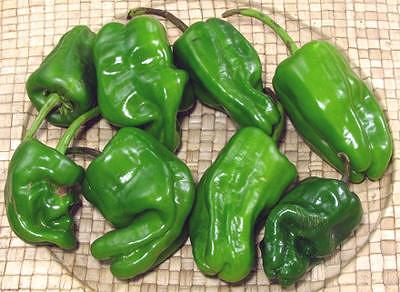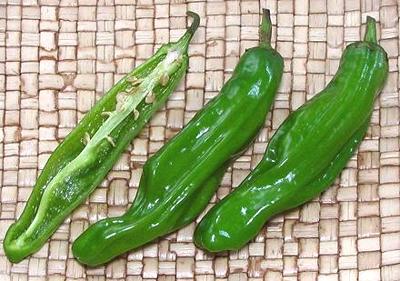 [Pimientos de Padrón (Spain); C.annuum]
[Pimientos de Padrón (Spain); C.annuum]
From the concello of Padrón in the northwest corner of Spain, these peppers are wrinkly in shape and erratic in heat. The saying is, "Padrón Peppers, some are hot, some are not". Those in the photo were grown in Southern California and were just a little hot. The largest was 2-3/4 inches long and 1-1/2 inches diameter. In weight they run from about 1/2 ounce to 1-1/4 ounces. Subst: The Japanese Shishito Chili is an excellent substitute.
More on Chili Peppers.
 [Japanese Chile; C. annuum]
[Japanese Chile; C. annuum]
Fresh dark green (red ones are very rare), these chilis have unique lengthwise ridges and blunt ends. They have good flavor are generally very mild at H0 but about 1 in 20 can surprise, cranking it up into the H1 range. This is the same as the much stubbier but similarly wrinkled Spanish Padrón pepper, from which the Shishito Chili was probably developed. Like other California produce, they are tending to get larger (easier to harvest). For my earlier photo the largest was 3 inches long and 1/2 inch diameter. A recent purchase (Oct 2017) was up to 4-3/4 inches long and 7/8 inch diameter, but still very mild.
The name in Japanese translates roughly to "Lion Chili", as they imagine the end looks like a lion's head. I sure can't see that, but a people who can name a piloted suicide bomb "Cherry Blossom" is capable of any naming perversion.
More on Chili Peppers.